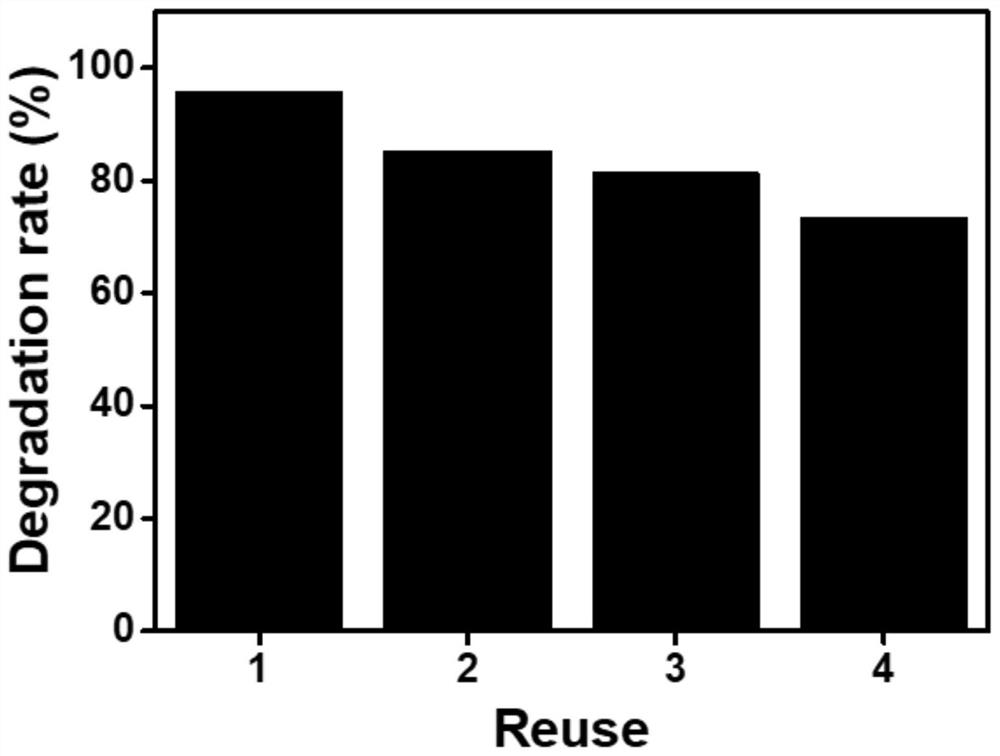Er-Fe2O3/BiVO4 photocatalyst for degrading rhodamine B and preparation method thereof
An er-fe2o3, photocatalyst technology, applied in metal/metal oxide/metal hydroxide catalysts, physical/chemical process catalysts, chemical instruments and methods, etc., can solve the problem of low utilization of sunlight and no catalytic activity , limit the application of catalysts, etc.
- Summary
- Abstract
- Description
- Claims
- Application Information
AI Technical Summary
Problems solved by technology
Method used
Image
Examples
Embodiment 1
[0023] (1)Er-Fe 2 o 3 Precursor preparation: 0.5mmol Er 2 o 3 Dissolve in 0.1mol / L nitric acid solution, add 4mmol Fe(NO 3 ) 3 9H 2 O and 5mmol (NH 4 ) 3 C 6 h 5 o 7 After continuing to stir and dissolve, dilute to 70mL with deionized water, and then place it in a polytetrafluoroethylene liner reactor at 140°C for hydrothermal reaction for 12h. After the reaction is completed, the product is centrifuged, washed, and dried to obtain Er-Fe 2 o 3 Precursor;
[0024] (2)Er-Fe 2 o 3 The preparation of: the step (1) is made Er-Fe 2 o 3 The precursor was placed in a muffle furnace and calcined in the air for 4h at a temperature of 600°C to collect Er-Fe 2 o 3 ;
[0025] (3)Er-Fe 2 o 3 / BiVO 4 Preparation: Weigh 5mmol Bi(NO 3 ) 3 ·5H 2 O was dissolved in 10mL nitric acid solution, and 5mmol NH 4 VO 3 Dissolve in 10mL 2mol / L NaOH solution, Bi(NO 3 ) 3 The solution was added dropwise to NH 4 VO 3 In the solution, add the Er-Fe that step (2) makes after magn...
Embodiment 2
[0029] (1)Er-Fe 2 o 3 Precursor preparation: 0.8mmol Er 2 o 3 Dissolve in 0.1mol / L nitric acid solution, add 5mmol Fe(NO 3 ) 3 9H 2 O and 6mmol (NH 4 ) 3 C 6 h 5 o 7 After continuing to stir and dissolve, dilute to 70mL with deionized water, and then place it in a polytetrafluoroethylene liner reactor at 140°C for hydrothermal reaction for 12h. After the reaction is completed, the product is centrifuged, washed, and dried to obtain Er-Fe 2 o 3 Precursor;
[0030] (2)Er-Fe 2 o 3 The preparation of: the step (1) is made Er-Fe 2 o 3 The precursor was placed in a muffle furnace and calcined in the air for 3h at a temperature of 500°C to collect Er-Fe 2 o 3 ;
[0031] (3)Er-Fe 2 o 3 / BiVO 4 Preparation: Weigh 6mmol Bi(NO 3 ) 3 ·5H 2 O was dissolved in 10mL nitric acid solution, and 7mmol NH 4 VO 3 Dissolve in 10mL 2mol / L NaOH solution, Bi(NO 3 ) 3 The solution was added dropwise to NH 4 VO 3 In the solution, add the Er-Fe that step (2) makes after magn...
Embodiment 3
[0033] (1)Er-Fe 2 o 3 Precursor preparation: 1 mmol Er 2 o 3 Dissolve in 0.1mol / L nitric acid solution, add 6mmol Fe(NO 3 ) 3 9H 2 O and 7mmol (NH 4 ) 3 C 6 h 5 o 7 After continuing to stir and dissolve, dilute to 70mL with deionized water, and then place it in a polytetrafluoroethylene liner reactor at 140°C for hydrothermal reaction for 12h. After the reaction is completed, the product is centrifuged, washed, and dried to obtain Er-Fe 2 o 3 Precursor;
[0034] (2)Er-Fe 2 o 3 The preparation of: the step (1) is made Er-Fe 2 o 3 The precursor was placed in a muffle furnace and calcined in the air for 2h at a temperature of 800°C to collect Er-Fe 2 o 3 ;
[0035] (3)Er-Fe 2 o 3 / BiVO 4 Preparation: Weigh 4mmol Bi(NO 3 ) 3 ·5H 2 O was dissolved in 10mL nitric acid solution, and 6mmol NH 4 VO 3 Dissolve in 10mL 2mol / L NaOH solution, Bi(NO 3 ) 3 The solution was added dropwise to NH 4 VO 3 In the solution, add the Er-Fe that step (2) makes after magne...
PUM
 Login to View More
Login to View More Abstract
Description
Claims
Application Information
 Login to View More
Login to View More - R&D
- Intellectual Property
- Life Sciences
- Materials
- Tech Scout
- Unparalleled Data Quality
- Higher Quality Content
- 60% Fewer Hallucinations
Browse by: Latest US Patents, China's latest patents, Technical Efficacy Thesaurus, Application Domain, Technology Topic, Popular Technical Reports.
© 2025 PatSnap. All rights reserved.Legal|Privacy policy|Modern Slavery Act Transparency Statement|Sitemap|About US| Contact US: help@patsnap.com



